
The Russulales are an order of the Agaricomycetes,. According to the Dictionary of the Fungi, the order consists of 12 families, 80 genera, and 1767 species. According to Species Fungorum, the order contains 13 families, 117 genera, and 3,060 species.
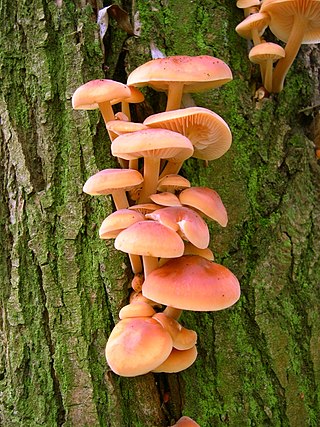
Flammulina is a genus of fungi in the family Physalacriaceae. The genus, widespread in temperate regions, has been estimated to contain 10 species.

Grifola is a genus of fungi in the family Meripilaceae, which includes some edible fungi such as Grifola frondosa, commonly known as hen-of-the-woods ; not to be confused with Laetiporus sulphureus, known among English speakers as chicken of the woods. The genus was circumscribed by Samuel Frederick Gray in 1821.

Panaeolus is a genus of small, black-spored, saprotrophic agarics. The word Panaeolus is Greek for "all variegated", alluding to the spotted gills of the mushrooms produced.
MycoBank is an online database, documenting new mycological names and combinations, eventually combined with descriptions and illustrations. It is run by the Westerdijk Fungal Biodiversity Institute in Utrecht.
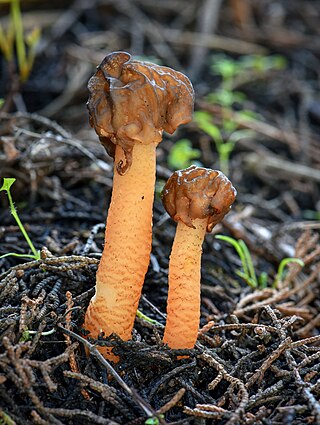
Verpa is a genus of ascomycete fungi related to the morels. Resembling the latter genus in edibility and form, the common name early morels is popular. There are five species in the widespread genus.

Polyozellus is a fungal genus in the family Thelephoraceae, a grouping of mushrooms known collectively as the leathery earthfans. Previously considered a monotypic genus, it now contains the Polyozellus multiplex species complex. The genus name is derived from the Greek poly meaning many, and oz, meaning branch. It is commonly known as the blue chanterelle, the clustered blue chanterelle, or, in Alaska, the black chanterelle. The distinctive fruit body of this species comprises blue- to purple-colored clusters of vase- or spoon-shaped caps with veiny wrinkles on the undersurface that run down the length of the stem.
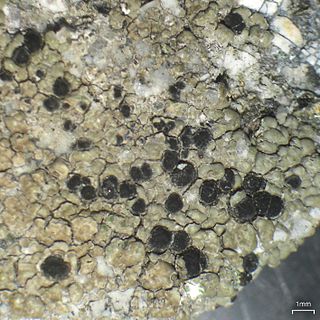
Lecidea is a genus of crustose lichens with a carbon-black ring or outer margin (exciple) around the fruiting body disc (apothecium), usually found growing on (saxicolous) or in (endolithic) rock. Lichens that have such a black exciple are called lecideine, meaning "like Lecidea, even if they are not in this genus. Members of the genus are commonly called disk lichens or tile lichens.
Palaeocephala is a genus of fungi. This is a monotypic genus, containing the single species Palaeocephala cymatelloides, described by Rolf Singer in 1962. According to the Dictionary of the Fungi, the genus is classified in either the Marasmiaceae or Physalacriaceae families; the taxonomical database MycoBank includes it in the Marasmiaceae.

Moniliophthora is a genus of fungi in the family Marasmiaceae. The genus was described in 1978 with M. roreri as the type species. This fungus, formerly known as Monilia roreri, causes frosty pod rot, a serious disease of Theobroma cacao.

Pleurocybella is a genus of fungi in the family Phyllotopsidaceae.
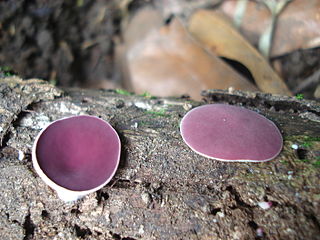
Phillipsia is a genus of fungi in the family Sarcoscyphaceae. There are about 17 species in the genus, which collectively have a widespread distribution in subtropical and tropical areas. The genus was circumscribed by Miles Joseph Berkeley in 1881. The generic name honours Wales-born English botanist William Phillips (1822–1905).
Sphaceloma is a genus of ascomycete fungi. Its species are plant pathogens, and cause anthracnose and scab diseases. The widespread genus is estimated to contain 52 species.
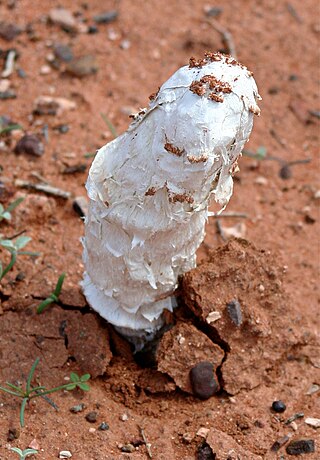
Phellorinia is a genus of fungi in the family Phelloriniaceae of the order Agaricales. The genus is monotypic, and contains the single species Phellorinia herculeana, described by English naturalist Miles Joseph Berkeley in 1843 as P. inquinans. This single species has currently 24 synonyms, and takes its epithet from the basionym Scleroderma herculeanum Pers.

The Phragmidiaceae are a family of rust fungi in the order Pucciniales. The family contains 14 genera and 164 species.

Leucangium is a genus of ascomycete fungi. The genus was circumscribed by French mycologist Lucien Quélet in 1883. Although classified in the Helvellaceae in the past, molecular analysis indicates it is closely related to the genus Fischerula and Imaia, and therefore must be placed in the Morchellaceae. The genus includes two species, Leucangium ophthalmosporum Quél. and L. carthusianum Paol., and both of them produce sequestrate ascoma, globose to ellipsoidal ascus, and dark olive-colored to grayish green, smooth, fusiform ascospores.
Gerwasia is a genus of rust fungi in the family Phragmidiaceae. Species in the genus grow on Rubus and Rosa plants.

Gymnoconia is a genus of rust fungi in the family Phragmidiaceae. G. nitens causes an orange rust of Rubus species.
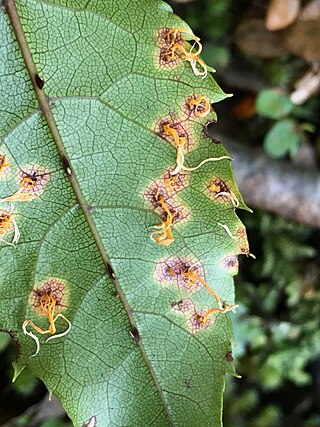
Hamaspora is a genus of rust fungi in the family Phragmidiaceae. The genus contains 14 species, which are known from Africa, Asia, and Australia.
The Morispora is a genus of rust fungi in the family Phragmidiaceae. The genus is monotypic, containing the single South American species Morispora tenella.















